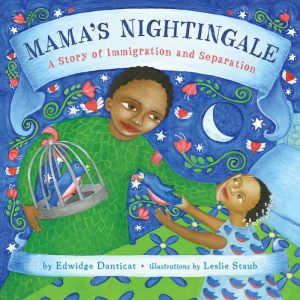 Mama’s Nightingale: A Story of Immigration and Separation
Mama’s Nightingale: A Story of Immigration and Separation
Written by Edwidge Danticat
Illustrated by Leslie Staub
Dial Books, 2015, 32 pp.
ISBN-13: 978-0-525-42809-1
Saya finds her life deeply disrupted when her mother is arrested and detained as an undocumented immigrant. Living alone with her father, Saya repeatedly listens to her mother’s voice recording on the answering machine in order to feel her mother’s presence. One day, however, Saya accidentally erases the message. Following a prison visit in which Saya has a hard time letting her mother go, her father gives her a cassette recording of her mother telling a story based on Haitian folklore. Included is a song that her mother sings to help Saya go to sleep. The song describes the mama nightingale looking for and finding her baby nightingale. Her father’s letter-writing campaign targeted to government officials and media outlets does not seem to be helping his wife’s case. Saya decides to write her version of the family crisis, and her father includes Saya’s letter with his own to the newspaper. Suddenly, the media pays attention and interviews them both for the newspaper and TV. The public gets involved with phone calls and letters, and eventually a judge rules that Mama can come home while her case is being considered. The story concludes when the family is reunited but with no resolution to the mother’s legal status in the country.
Mama’s Nightingale is an important addition to the literature on immigration, especially because the book is written from an immigrant’s perspective. Saya’s mother came to the United States before she met her husband. Saya and her father have legal status and their frustration and growing despair is palpable as they wonder if they will ever be together again as a family. The story acts as a counter narrative to the idea that immigrants just want jobs and focuses on the trauma of separation and its impact on a family.
This book is all about the power of voice and how one girl’s voice changes the circumstances for her mother. Undocumented immigrants are often voiceless for fear of calling attention to themselves and being deported. Through illustrated speech bubbles–some small and some that take over the page–the illustrations convey the power of voice: the comfort provided through a cassette tape of a mother’s story about looking for her baby nightingale; the powerlessness of the repeated letters the father writes to anyone he thinks might help; the power of Saya’s voice as she describes her longing for her mother; the power of the news media as they interview and broadcast Saya’s voice; the power of the public voice as they call and write letters of support; the voice of the gavel as the judge rules that Saya’s mother can be home with her family; and, finally, the power of a mother’s voice to soothe, comfort and love her child.
This book would pair well with stories of children taking action such as Something Beautiful (Sharon Dennis Wyeth, 1988) or How to Heal a Broken Wing (Bob Graham, 2008). It would also pair well with stories where a child’s voice makes a change in the story’s path such as The Recess Queen (Alexis O’Neill, 2002), René Has Two Last Names (René Colato Laínez, 2009), or My Two Blankets (Irena Kobald, 2015). It would also pair well with other books about undocumented immigrants such as Friends from the Other Side (Gloria Anzaldua, 1993).
Edwidge Danticat is a Haitian-American storyteller and writer. She spent her childhood in Haiti, living with her brother, aunt and uncle, while her parents worked without documentation in the United States. This is her first picture book; she is better known as a novelist depicting issues surrounding identity. She is also known to be an author who delves into the politics of the diaspora and mother-daughter relationships, both of which are prominent themes in this book.
New Orleans-based artist Leslie Staub uses the warm tropical colors of Haiti to illustrate the insightful, impactful pages in Mama’s Nightingale. Using a primitive style, Staub fills the illustrations with rich metaphor and symbolism depicting the love between family members, Haitian folklore, and the power of voice. Though the book would not be considered a bilingual text, Staub incorporates Haitian Creole that Danticat used in the written text into the illustrations, adding a rich linguistic layer to the book.
Susan Corapi, Trinity International University, Deerfield, IL
WOW Review, Volume IX, Issue 2 by Worlds of Words is licensed under a Creative Commons Attribution-NonCommercial-ShareAlike 4.0 International License. Based on work at https://wowlit.org/on-line-publications/review/ix-2/
